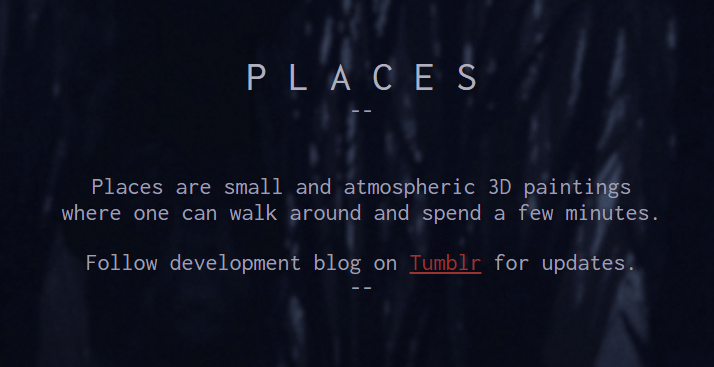For this week’s critical play on walking sims, I played Places for the first time – which in my opinion was less like a game, and more like 3-D paintings you could explore (which was honestly how the creator described it in the blurb on the home website). I played in my web browser, but for some places you could download and run on Linux and Windows machines. I played Place 3, Place 6, and Sketch 1. The target audience seemed to be players who appreciate a serene gaming experience focused on exploration, story, and atmosphere rather than action or puzzle solving. I could see older players enjoying the relaxing gameplay, or just art enjoyers looking a different kind of emotional and aesthetic experience. Places was created by https://ktch0.tumblr.com/.
In Places, walking plays a central role in storytelling by creating an immersive experience that simulates the player being actually physically present within the game’s environment. This physicality in movement allows players to feel as though they are living the story, rather than merely observing it as an artwork. This feeling of “being there” is a critical component of the game’s design, formed by some of its formal elements and especially its mechanics – though I believe Places does fall short in a few respects when it comes to ideal player immersion.
When it comes to its formal elements, interaction (or lack thereof), objectives, and boundaries play the biggest role in Places. There are no other players to interact with, but there are things you can pick up, though they won’t be highlighted or suggested to you. The ability to pick up objects without a clear purpose can lead to player frustration, as it did with me, since I felt like I was missing out on potential interactions. However, this made it feel more like real life, with the freedom to do what I wanted without thinking I had to do something. I also appreciated the main objective to just be exploration. It helped deepen the theme and the narrative for me, as I wasn’t distracted by quests or tasks – I could just realize my own curiosity through the game. However, some limitations to the games often broke me out of the flow of exploration, such as in Place 6 where I tried to swim down through the water but couldn’t. I felt a need for varied environmental interactions, which would have further expanded the narrative and exploratory possibilities of the game. Allowing players to interact with water bodies or other landscape features would have made exploration even more realistic and immersive, offering new ways to engage as well, instead of bringing you back to reality that it’s just a 3D painting.  Water in Place6
Water in Place6
Meanwhile, the boundaries successfully made the realms seem like their own special microcosm of reality, but would often also take me out of the immersion as I would run into them quite quickly. I would hit the edge of the map after only a few minutes of wandering, leaving me disappointed. I feel like this abrupt of a boundary illustrates a limitation in Places’ design, as it disrupted the narrative immersion. I wish that as a walking simulator, It would send me to the other edge of the map or something, so I could just keep walking instead of hitting a wall.

Me at the edges of the map in Sketch1 and Place3^
Finally, when we look at Places through the MDA lens, we can see that it relies more so on the mechanics and is lacking in some of the dynamics and aesthetics. Walking as a primary mechanic encourages players to explore at their own pace, helping me feel like I was fostering a personal connection to the game world. However, I felt like there were underutilized mechanics included as an afterthought like object interaction, maybe suggesting a need for refinement to fully integrate these elements into the local narrative of each place. I found that in Places, the dynamics of exploration are influenced by the specific environment’s design and my ability to interact with it. I felt like as a walking simulator, more effective dynamics could involve evolving landscapes or contexts that responded to my actions or movement, which in Places would lead to more meaningful interactions. I felt like the aesthetic goal of immersion and serenity was Places’ focus, which I found was successfully achieved through detailed environments and atmospheric soundscapes. However, varying the auditory and interaction design could further enrich the aesthetic experience, making each area feel unique and integral to the overall story. Instead, there was just fairly standard scuffing noises for walking and splashing for swimming. In Place 3, there was no sound, which I understand may be for the snow, but I didn’t like my experience in Place 3 as much because of it. I think this highlights the importance of audio in creating a compelling game aesthetic. Sound not only enhances realism and immersion of walking sims, but also emotionally anchors players to the environment, making each step feel significant and purposeful – even if there really is no purpose in a walking sim but to pretend like you’re actually there.
I have not played other walking sims before, but I have played games like Free Realms (no longer playable), where it is a very large open world MMORPG. I liked how the walking reminded me of my experiences with these, as part of Free Realms’ fun was exploring the many worlds and completing the various tasks and quests you could find there, again making it seem like I was really the one doing them. What I missed most from games like this in Places was a more cohesive and conscious story – Places is beautiful, but aimless, and while this works for immersion temporarily, I won’t keep coming back to it because of it. Real life is already aimless in that sense.




